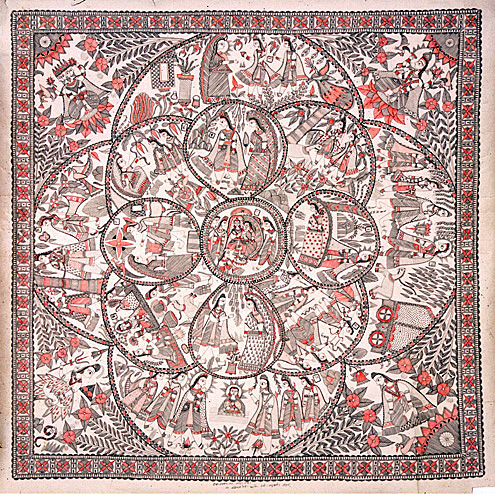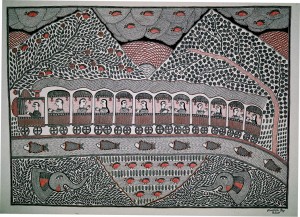Mithila Art as a Communication Technology
 Long before there were computers in most of our homes, there was Mithila Art in homes of what is now India and Nepal. Originally, this folk art form mainly consisted of lively murals painted on the walls of homes in rural villages. But it was much more than simple art for art’s sake. “Mithila painting is part decoration, part social commentary, recording the lives of rural women in a society where reading and writing are reserved for high-caste men” (Arminton, Bindloss & Mayhew, 2006, p. 315). This was art that gave a voice to powerless rural women as a communication technology.
Long before there were computers in most of our homes, there was Mithila Art in homes of what is now India and Nepal. Originally, this folk art form mainly consisted of lively murals painted on the walls of homes in rural villages. But it was much more than simple art for art’s sake. “Mithila painting is part decoration, part social commentary, recording the lives of rural women in a society where reading and writing are reserved for high-caste men” (Arminton, Bindloss & Mayhew, 2006, p. 315). This was art that gave a voice to powerless rural women as a communication technology.
Historical and Cultural Context
This art form acquired its name from the kingdom of Mithila where it originated around the seventh century A.D. At that time, the region was a vast plane located primarily in what is now eastern India as well as in southern Nepal. However, the cultural center and capital of the region was in what is now the city of Janakpur, Nepal only 20 kilometers from the Indian boarder. Janakpur is of course the home of Janakpur painting while the town of Madubandi, India is home of paintings of the same name. Mithila art consists of both kinds of paintings of which Madubandi are more common.
It is said that Mithila art was born when King Janak commissioned artists to create paintings at the time of the marriage of his daughter, Sita, to the god Lord Ram. This might have to do with the fact that most Madubani paintings are created during festivals celebrating marriages and births, religious and social events and ceremonies of the Maithil community. Others say that, “Its original inspiration emerged out of the local women’s craving for religiousness and an intense desire to be one with god” (Janakpur Women’s Development Center, n.d.). However it actually began is not clear, but what it became after being passed down through many generations surly is.
“Mithila is a wonderful land where art and scholarship, laukika and Vedic traditions flourished together in complete harmony between the two” (Mishra, 2009, 4). This harmony was uncommon during this time in many other regions in southern Asia as well as the rest of the world. The general attitude toward artists in this region is one of utmost respect and they were even compared with gods. That could be a major reason why women in ancient Indian society, whom were traditionally regarded as much less significant than men, adopted Mithila art as well as other art forms as not only a communication technology, but as a means for empowerment as well.
“Picture writing is perhaps constructed culturally (even today) as closer to the reader, because it does not depend upon the intermediary of spoken language and seems to reproduce places and events directly” (Bolter, 2001, p. 59). The murals were originally painted during important community events as a kind of subjective snapshot as well as social commentary. This was a positive way for rural women to have a voice and to be heard.
Implications for Literacy and Education
In a communicative context, ‘literacy’ is commonly defined as “the ability to read and write” where to ‘write’ is defined as to “mark (letters, words, or other symbols) on a surface, with a pen, pencil, or similar implement” (Oxford University Press, 2009). So although most Mithila artists were not literate in phonetic writing, they were exceptionally literate in picture writing. As with oral communication, this type of literacy served to bring people together and strengthen their communities. “As we look back through thousands of years of phonetic literacy, the appeal of traditional picture writing is its promise of immediacy. By the standard of phonetic writing, however, picture writing lacks narrative power” (Bolter, 2001, p. 59). The “narrative power” of which Bolter refers to, is the ability of phonetic writing to convey detailed information from a first person perspective. Unfortunately, this ability also has a tendency to actually distance those in communication rather than bring them together as in picture writing.
Bolter goes on to write that, “Sometimes, particularly when the picture text is a narrative, the elements seem to aim for the specificity of language. Sometimes, these same elements move back into a world of pure form and become shapes that we admire for their visual economy” (2001, p. 63). This explains the duality of this art form as both a communication technology and an aesthetic art form. Another perspective of visual communication technologies is that, “Display is, in respect to its prominence and significance and ubiquity, the analogue of narrative” (Kress, 2005, p.14). So while Mithila paintings perhaps lacked the ability to convey a first person narrative, they narrowed the gap between the composer and her audience in a beautiful visual mode of communication.
For the Maithil artists, the ability to express their desires, dreams, expectations, hopes and aspirations to their community in (picture) writing through their painting was most likely much more valuable than communicating detailed information to outsiders by means of phonetic writing. “Unlike words, depictions are full of meaning: they are always specific. So on the one hand there is a finite stock of words—vague, general, nearly empty of meaning; on the other hand there is a n infinitely large potential of depictions—precise, specific, and full of meaning” (Kress, 2005, pgs.15-16). The meaning they conveyed through their art was unmistakable and accessible to all. In this case, picture writing literacy did not lead to phonetic or alphabetic writing literacy. It did, however, require education.
As all writing is communication technology, Mithal art required education to master the particular tools, materials and techniques of this unique style of picture writing. Most of these artists were not formally educated and were illiterate in the ways of phonetic reading and writing. But they did have to learn about the range of natural hues that could be derived from preparations and combinations of clay, bark, flowers and berries as well as how to fashion brushes from bamboo twigs and small pieces of cloth (Mishra, 2009).
Conclusion
Although Mithila art did not directly lead ancient India to a conventional sense of literacy nor to formal education of the masses, it did give a voice to the voiceless. As a communication technology, it provided something for those artists that was and remains a critical element of their society: a heightened consciousness. As Ong writes, “Technologies are not mere exterior aids but also interior transformations of consciousness, and never more than when they affect the word. Such transformations can be uplifting. Writing heightens consciousness” (2002, p. 81).
Mithila art still exists today, but unfortunately has been commercialized with the introduction of tourism. Much of what this art form and communication technology was and did for these people has been lost. Most pieces are painted on paper and many are of scenes made-to-order that have nothing to do with Maithil culture, although selling their artwork has proved an increasing source of income and has in turn improved their quality of live. With the support and guidance development organizations, groups are now promoting the consumption of Vitamin A, voting, safe sex, and saying “no” to drugs to their communities (Janakpur Women’s Development Center, n.d.). So although it has changed considerably over many generations, Mithila art is still a meaningful communication technology.

References
Armington, S., Bindloss, J., & Meyhew, B. (2006). Lonely Planet: Nepal. Oakland, CA: Lonely Planet
Bolter, D. (2001). Writing Space: Computers, Hypertext, and the Remediation of Print. Mahwah, NJ: Lawrence Erlbaum Associates, Inc.
Janakpur Women’s Development Center. (n.d.). Retrieved October 3, 2009, from http://web.mac.com/nadjagrimm/iWeb/JWDC/Welcome.html
Kress, G. (2005). Gains and losses: New forms of text, knowledge, and learning. Computers and Composition, 22, 5-22. Retrieved from http://www.sciencedirect.com/science
Mishra, K. K. (2009). Mithila Paintings: Past, Present and Future. Retrieved October 4, 2009 from Indira Gandhi National Centre for the Arts. Web site: http://ignca.nic.in/
Mithila Art – Madhubani Painting and Beyond. (n.d.). Retrieved October 3, 2009, from http://mithilaart.com/default.aspx
Ong, W. J. (2002). Orality and Literacy. New York: Routledge
Oxford University Press. (2009). Ask Oxford. Retrieved October 10th, 2009 from http://www.askoxford.com/


1 comment
1 Catherine Gagnon { 11.02.09 at 10:22 am }
Ryan, I avidly read your research on Mithila art as I have an interest in anything that discusses the empowerment of women. I think you have empowered them in bringing to light this form of written communication and the training they received in developing their art. I would not have thought, until I read this project, that textile art could be written communication. I suppose the same was true of the tapestries women created in medieval times or even much of the native textile arts.
Very enjoyable and enlightening.
You must log in to post a comment.